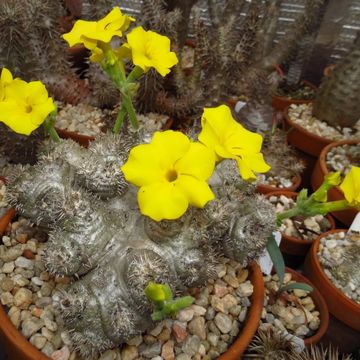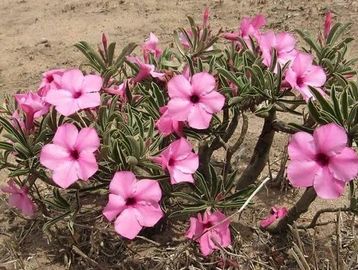Caudiciforms
Pachypodium
Pachypodium is a genus of succulent, spiny plants native to Madagascar and RSA. Characterized by their thick, water-storing stems and striking, often branching forms, these plants are well-adapted to arid environments. The leaves are typically sparse, and some species shed them entirely in dry seasons. Pachypodiums produce unique, trumpet-shaped flowers ranging in color from white to pink. The genus has garnered botanical interest due to its diverse morphology and adaptation to harsh climates.
.jpeg/:/cr=t:6.2%25,l:0%25,w:100%25,h:74.84%25/rs=w:360,h:360,cg:true)
Pachypodium Cactipes
It is a rare succulent plant of a caudiciform shape. Its light gray trunk is covered with thorns, as well as with lanceolate leaves, sprouting from the apex. The foliage is dark green with a central strip of a creamy white color, the lower surface takes on purple shades. As P. cactipes grows, it tends to branch out, producing numerous short but thick branches. In winter, its canary yellow flowers bloom. In the period of vegetative rest it loses its leaves, leaving a baron grey plant.

Pachypodium Lamerei
Add a description about this item

Pachypodium Horombense
Add a description about this item

Pachypodium Geayi
Add a description about this item

Pachypodium Succulentum
Add a description about this item

Pachypodium Bisponosum
Add a description about this item

Pachypodium Saunderisii
Add a description about this item
Adeniums
Adeniums, scientifically classified in the Apocynaceae family, intrigue enthusiasts with unique ecological adaptations. Commonly named Desert Roses, these succulents boast drought-resistant qualities, thriving in arid conditions. Characterized by vibrant trumpet-shaped flowers and distinctive caudex stems, Adeniums add a touch of scientific elegance to gardens. Explore our diverse collection, selecting from various sizes and colors to enrich your collections with these resilient specimens.

Adenium Obesum
Adenium obesum, the "Desert Rose," is a captivating succulent native to arid Africa and the Middle East. With a distinctive swollen trunk, glossy green leaves, and vibrant trumpet-shaped flowers in shades of pink to red, it's a sought-after ornamental plant. Thriving in warm, dry climates, it's ideal for both indoor and outdoor cultivation, adding a touch of exotic beauty to any space.
.jpeg/:/cr=t:0%25,l:5.67%25,w:88.67%25,h:100%25/rs=w:360,h:270.6766917293233,cg:true)
Adenium Multiflorum
Adenium multiflorum, a member of the Apocynaceae family, is a captivating succulent native to arid regions of Africa. This species, commonly known as the Impala Lily, exhibits a distinctive caudex structure and slender branches adorned with lanceolate leaves. The plant's name reflects its remarkable attribute of producing multiple flowers, forming dense inflorescences with striking hues ranging from pink to red. Adapted to thrive in challenging conditions, Adenium multiflorum showcases resilienc
.jpeg/:/cr=t:0%25,l:0.12%25,w:99.75%25,h:100%25/rs=w:360,h:270.6766917293233,cg:true)
Adenia Fruticosa
Adenia fruiticosa, commonly known as the "African Bulbine," is a distinctive plant species native to tropical Africa. Characterized by its succulent stems and unique bulbous base, this perennial plant belongs to the Passifloraceae family. Adaptable to various environments, it often thrives in rocky or sandy soils. The plant's lobed leaves and intricate, star-shaped flowers add to its ornamental appeal. Making it an interesting addition to any caudiciform collection.

Adenium Swazicum
Despite its resilience to drought, Adenium Swazicum is vulnerable to habitat loss and overexploitation due to illegal collection for the horticultural trade. Conservation efforts are underway to protect remaining populations and ensure the long-term survival of this unique desert species. Currently we have 2 breeding pairs with permits from Kruger national park, in an attempt to breed and preserve the species.
Add a footnote if this applies to your business
Copyright © 2024 weirdandwonderfulplants.com - All Rights Reserved.
Powered by GoDaddy
This website uses cookies.
We use cookies to analyze website traffic and optimize your website experience. By accepting our use of cookies, your data will be aggregated with all other user data.